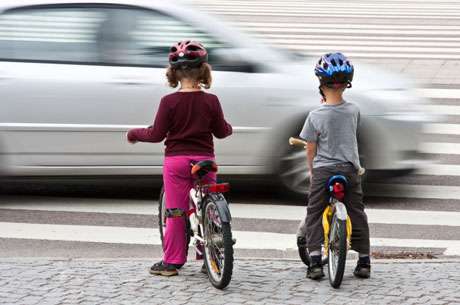Many children affected by posttraumatic stress disorder after traffic accidents

Nearly every third child in Sweden who is injured in traffic is subsequently affected by posttraumatic stress disorder. Every fifth child is still suffering from mental and psychosocial problems one year after the accident. These are the conclusions of a thesis submitted at the Sahlgrenska Academy, which shows also that only 6 out of 10 Swedish children and adolescents who are involved in a traffic accidents wear a helmet when cycling.
Research student Eva Olofsson has examined the consequences of road traffic injuries in children. One of her studies shows that approximately 30% of children who are injured in traffic suffer from posttraumatic stress disorder one month after the accident.
Life in danger
The stress disorder lasts from three to six months in one sixth of the children.
"The children often experience much stress and fear in association with the accident, and may feel that their life is in danger. This can cause posttraumatic stress disorder (anxiety disorder) in the long term, and this may constitute a major obstacle in their everyday lives," says Eva Olofsson.
Psychosocial problems
Another study asked 292 children who had been injured in traffic in the Gothenburg region about residual consequences of the accident. The children completed a questionnaire, which showed that one year after the accident 22% of the children were still suffering from mental and psychosocial problems connected with it.
This means that residual mental problems are more common among children who have been in an accident than physical problems (which affected 16% of children injured in traffic in the Gothenburg region).
The residual mental problems were, however, not related to the severity of the physical injuries.
"My results suggest that the experience of having an accident has a greater effect that the actual physical injuries. To be injured as an unprotected pedestrian in an accident with a vehicle can be experienced are more stressful, more frightening and more threatening than, for example, a cycling accident with no-one else involved. We saw also that receiving care as an inpatient, with procedures that may be experienced as frightening in an unfamiliar environment, may produce more stress than receiving care at a clinic and being allowed home the same day."
Cycle accidents most common
Cycling accidents are the most common cause of traffic injuries in children. Eva Olofsson's results show that it has become significantly more common that children who are injured in traffic are wearing a cycle helmet: In 1993 approximately 40% of children who were injured were wearing a helmet, while the figure in 2006 was 80%.
The fraction of children with skull or brain injuries after a cycling accident who received care at Drottning Silvia's Children's Hospital in Gothenburg fell during the period 1993-2006, but the fall was not statistically significant.
The incidence of facial injuries also fell, while the fraction with injuries to the arms, in contrast, increased.
"We can see that a cycle helmet provides good protection against severe and life-threatening skull and brain injuries, in all types of cycling accident. Further, a helmet protects against facial injuries," says Eva Olofsson.
Teenagers dumps the helmet
However, teenagers, particularly girls, are significantly less likely to wear a helmet. Despite new legislation in 2005 that stipulates that everyone under the age of 16 years must wear a helmet, less than 60% of children wore a helmet when cycling to and from school in 2012. Only 32% of cyclists in Sweden, adults and children, wore a helmet when cycling.
Eva Olofsson has worked as a nurse for more than 20 years, and has long experience of working with children injured in traffic accidents.
"Children are very vulnerable in traffic. It's important to determine what consequences a traffic injury may have for them, such that they can receive optimal care," says Eva.
Her conclusion is that the Accident & Emergency healthcare service should develop procedures to identify and follow up children injured in traffic who risk long-term mental, psychosocial and physical problems.
More information: Thesis: gupea.ub.gu.se/handle/2077/34397
















